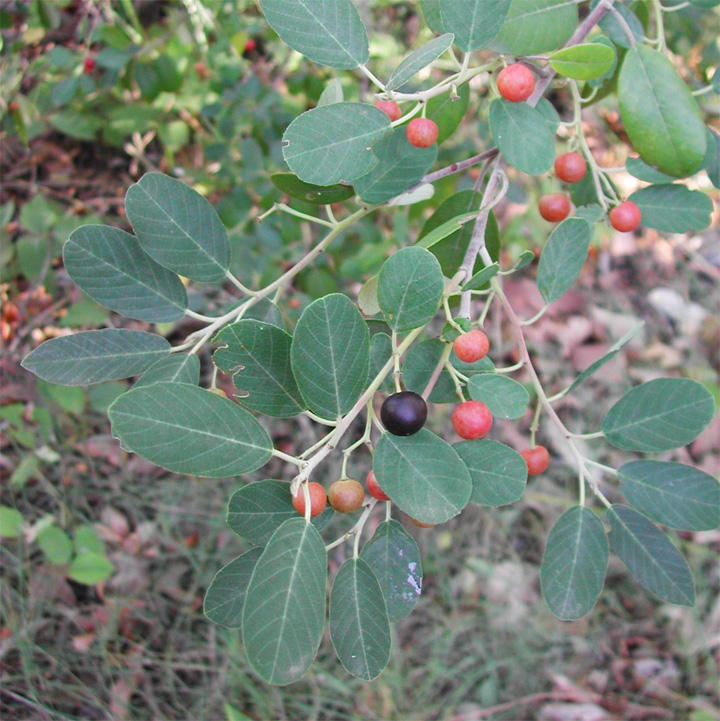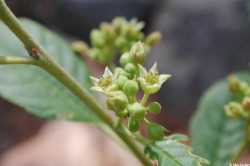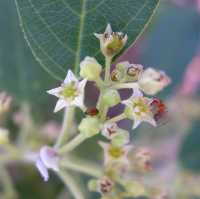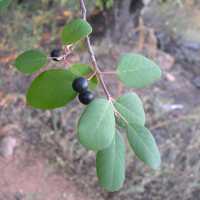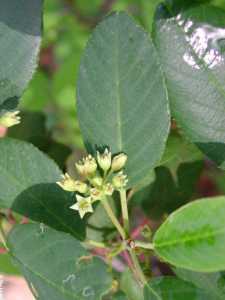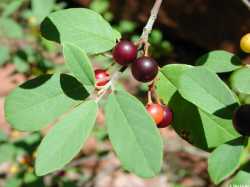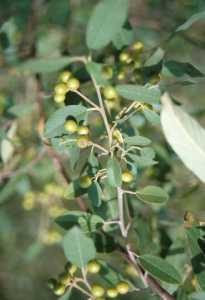PLANT: Shrubs to 5.5 m tall.
STEMS: gray to red.
LEAVES: thick, evergreen; petioles 0.5-1.7 cm long; blades elliptic to obovate, 2.8-8.5 cm long, 1.4-3.8 (-4.5) cm wide, green, glabrous on the upper surface and glabrous to white-tomentose on the lower surface.
FLOWERS: 4-27 (-34) per inflorescence; sepals 2 mm long; petals brownish; stigma 2-lobed. FRUITS 0.6-1.2 cm wide; seeds 2.
NOTES: 6 subspp. (1 in AZ); OR, CA & NV, west to NM.
REFERENCES: Kyle Christie, Michael Currie, Laura Smith Davis, Mar-Elise Hill, Suzanne Neal, and Tina Ayers, 2006 Vascular Plants of Arizona: Rhamnaceae. CANOTIA 2(1): 23-46.
Common Name: California buckthorn
Duration: Perennial
Nativity: Native
Lifeform: Tree
Wetland Status: FACW
General: Shrubs to 5.5 m tall, with gray to red canescent stems, branches mostly alternate.
Leaves: Alternate, thick, evergreen, on petioles 0.5-1.7 cm long, blades elliptic to obovate, 2.8-8.5 cm long, 1.4-3.8 cm wide, green, glabrous on upper surface and glabrous to white-tomentose on the lower surface.
Flowers: Axillary cymes of 4-27 flowers, five petals, stamens, and sepals; sepals yellow, 2 mm long, petals brownish, 2-lobed stigma.
Fruits: Drupe, purplish-black when ripe, spherical, glabrous, stones 2-3, smooth.
Ecology: Found in chaparral, coniferous forests, and along riparian areas from 3,500-6,500 ft (1067-1981 m); flowers May-June.
Notes: Distinguished by its evergreen leaves, usually white-tomentose beneath, elliptic, with a 2-lobed stigma, and 2-stoned fruits. There is subspecies ssp. ursina, which is distinguished by by being green and nearly glabrous on the leaves upper surface, and paler green and white-tomentose beneath, the margins are also slightly revolute, serrate to entire. One other note: Frangula x blumeri is thought to be a hybrid between this species and F. betulifolia and is from a collection from the Chiricahuas.
Ethnobotany: Root used for toothaches, as a purgative and laxative, as an aid in case of poison ivy, to counteract poisoning, as a burn dressing, or for infected sores, as a cathartic, for kidney troubles, for grippe, mania, rheumatism, and the berries were eaten raw, dried, or made into mush or jams.
Etymology: Frangula is thought to mean fragile, referring to the brittle twigs of alder, while californica means of or from California.
Synonyms: None, but there is question if there is one or two subspecies.
Editor: SBuckley, 2010


